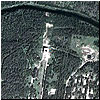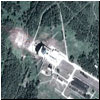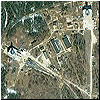|
Launch facilities for R-7-based rockets in Plesetsk
A satellite view of launch facilities for R-7-based rockets in Plesetsk. (CLICKABLE) Credit: Google Earth
|
|||||||||||||||||||||||||||||||||||||||||||||||
| HISTORY | ||||||||||||||||||||||||||||||||||||||||||||||||
|
|
|||||||||||||||||||||||||||||||||||||||||||||||
|
History of launch facilities for R-7-based rockets in Plesetsk At the end of the 1950s, first two battle-ready launch pads for R-7A missiles were founded north of Moscow near the town of Plesetsk to become the first Soviet operational ICBM base aiming nuclear-tipped weapons at the American continent. To maintain secrecy, the site was identified in military documentation as the 3 UAP -- the Russian abbreviation for the 3rd Training Artillery Range. |
|||||||||||||||||||||||||||||||||||||||||||||||
| FACILITIES | ||||||||||||||||||||||||||||||||||||||||||||||||
 |
The construction of the original launch pad in Plesetsk known as (Pad No. 1 or SK-1) was officially completed on Dec. 15, 1959. At the time, the R-7 ICBM was still in development and, as a result, the launch hardware had to be constantly tuned up in the course of construction to reflect changes introduced into the missile. Still, benefiting from the experience in Tyuratam, the first pad in Plesetsk required 800,000 tons less Earth moving and 14,000 cubic meters less concrete work. |
|||||||||||||||||||||||||||||||||||||||||||||||
 |
Soon after the completion of Pad No. 1 for the R-7 missile in Plesetsk, a second pad was built northeast from the original launch complex. A military unit No. 14003 responsible for all operations at Pad No. 2 was officially declared to be on duty on April 15, 1960. It would also become a space launch site, however, unlike its predecessor it has remained operational until this day. |
|||||||||||||||||||||||||||||||||||||||||||||||
 |
A dual launch facility completed original plans for the deployment of R-7 ICBMs in Plesetsk, brining a total of number of pads for the missile to four and counting two pads in Tyuratam to six. Several other remote sites throughout the USSR were selected for the deployment of R-7, but had never been developed. In the meantime, the very last launch pad built for the R-7 missile in Plesetsk, would stand to see the latest incarnations of the R-7 rocket -- Soyuz-2 and Soyuz-1. |
|||||||||||||||||||||||||||||||||||||||||||||||
 |
Site 142 The main satellite processing facility of Plesetsk was located at Site 142. During the 1970s and 1980s, it was probably the busiest spacecraft processing "factory" in the world. |
|||||||||||||||||||||||||||||||||||||||||||||||